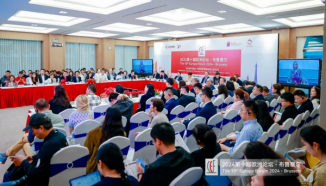Research Breakthroughs Attract Global Attention
2022 has been an exceptional year of scientific achievements for BGI-Research.
In March, Nature announced that BGI-Research and its partners had discovered a transgene-free, rapid, and controllable method to convert pluripotent stem-cells into bona fide 8-cell totipotent embryo-like cells, paving the way for advances in organ regeneration and synthetic biology.
In April, BGI-Research published the world's first non-human primate whole cell atlas in Nature.
In May, the spatiotemporal atlas of mouse embryonic development using BGI-Research's spatiotemporal omics technology, Stereo-seq, was published in Cell, featuring on the cover. Stereo-seq also helped produce the first spatiotemporal maps of Drosophila, zebrafish, and Arabidopsis, published in Developmental Cell.
And in September, BGI-Research's world-first salamander brain regeneration spatiotemporal atlas featured on the cover of Science.

While these have been exceptional months, BGI-Research has been at the forefront of scientific research for more than two decades, with achievements including:
Sequencing 1% of the human genome as part of the Human Genome Project;
Completing the first sequencing of the rice genome;
Constructing a reference gene set of human gut microbes and releasing the human intestinal bacterial genome set;
Building a high-throughput automated synthetic biology platform to synthethize the first eukaryote;
Discovering the third phylum of green plants other than Streptophyta and Chlorophyta, opening up a whole new world of life that had never been discovered before; and
Helping to found the Earth BioGenome Project.

Some of the many scientific journal cover stories generated through research BGI has led or collaborated on over the years
BGI's leading global position in life sciences has also been recognized in the 2022 Nature Index where BGI rose two places to 8th in the world among corporate institutions for its contribution to life science research and held on to the top spot in the Asia Pacific region for the 7th consecutive year.
BGI-Research's latest breakthroughs in the two core tools of single-cell sequencing technology and Stereo-seq have enabled researchers to observe life from new perspectives, and these advances are rightly being recognised by major international scientific publications.
The enormous scientific interest in spatiotemporal omics also encouraged BGI to initiate the SpatioTemporal Omics Consortium (STOC), which currently includes more than 120 leading scientists from 25 countries.
In the past, humans used microscopes to observe life. We could only see the morphology of cells without molecular and mechanical explanations. DNA sequencing technology made it possible to glean DNA molecule information, but without structural information. For the first time in history, BGI's Stereo-seq technology has integrated structure and function.
Today, using BGI's single-cell library sequencing and Stereo-seq technologies, scientists can perform multi-dimensional analysis at lower-cost, with high sensitivity, high speed, and greater accuracy than ever before.
This progress in the field of life science research tools has allowed our understanding of ourselves, life, old age, illness and death, and the growth of all things to enter a new era. In the future, BGI-Research will work with researchers around the world to jointly promote the comprehensive development of organ maps, disease pathology, ontogenesis and life evolution – a future that will benefit all of us.

 Login
Login Login
Login CCCEU and Gunnercooke Successfully Host Webinar on CSDDD and FLR Compliance to Guide Chinese Businesses
CCCEU and Gunnercooke Successfully Host Webinar on CSDDD and FLR Compliance to Guide Chinese Businesses Cultivating responsible China-EU business leaders essential to tackling global challenges
Cultivating responsible China-EU business leaders essential to tackling global challenges



